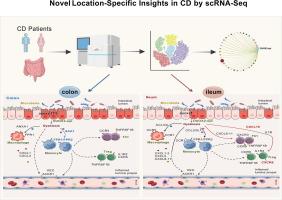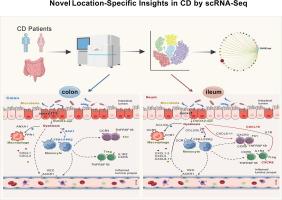Comprehensive analysis of heterogeneity and cell-cell interactions in Crohn’s disease reveals novel location-specific insights
IF 13
1区 综合性期刊
Q1 MULTIDISCIPLINARY SCIENCES
引用次数: 0
Abstract
Introduction
In Crohn’s disease (CD), lesions are mainly distributed in a segmental manner, with the primary sites of involvement being the ileum and colon. Heterogeneity in colon and ileum results in location-specific clinical presentations and therapeutic responses. Mucosal healing tends to be more readily and quickly achieved in the colon than in the ileum, where lesions are more likely to develop into complex behaviors. The heterogeneity of colon and ileum in CD, which is essential for tailored therapeutic approaches, has not yet been systematically illustrated.
Objectives
CD presents with unique intestinal lesions, mainly impacting the terminal ileum and colon. It is essential to comprehend the diversity in pathogenesis and treatment response among various segments.
Methods
We conducted comparative single-cell RNA sequencing analysis in treatment-naïve CD patients, concentrating on the colon and ileum.
Results
A novel subset of epithelial cells expressing high levels of DUOX2 and DUOXA2 (DUOX2-epi) was discovered. This DUOX2-epi subcluster predominantly distributed in the tip epithelium of the inflamed colon, potentially in response to microbial infection, as evidenced by the significant enrichment of inflammatory and microbial response pathways. The colonic and ileal DUOX2-epi subsets trigger inflammatory responses through distinct mechanisms. The colonic DUOX2-epi primarily affects monocytes via the SAA1-FPR2 ligand-receptor interaction, whereas the ileal DUOX2-epi directly interacts with regulate T cells through the CXCL16-CXCR6 ligand-receptor pair. Moreover, the cell–cell communication networks involving DUOX2-epi in the colon and ileum can help predict the location-specific effects of biological therapies.
Conclusion
This study delves into the heterogeneity within the ileum and colon of Crohn’s disease at the single-cell level, identifying a new epithelial subset DUOX2-epi. Predictive gene modules tailored to different locations for biological therapies are developed as well, based on the cell–cell communication network modulated by DUOX2-epi.


克罗恩病的异质性和细胞-细胞相互作用的综合分析揭示了新的位置特异性见解
在克罗恩病(CD)中,病变主要以节段性分布,主要受累部位为回肠和结肠。结肠和回肠的异质性导致了特定部位的临床表现和治疗反应。结肠粘膜愈合往往比回肠更容易、更快,因为回肠的病变更容易发展成复杂的行为。CD患者结肠和回肠的异质性是定制治疗方法所必需的,但尚未有系统的说明。目的cd表现出独特的肠道病变,主要累及回肠末端和结肠。了解不同部位的发病机制和治疗反应的多样性是至关重要的。方法对treatment-naïve CD患者进行比较单细胞RNA测序分析,主要集中在结肠和回肠。结果发现了一个新的表达高水平DUOX2和DUOXA2的上皮细胞亚群(DUOX2-epi)。这种DUOX2-epi亚簇主要分布在炎症结肠的尖端上皮,可能是对微生物感染的反应,炎症和微生物反应途径的显著富集证明了这一点。结肠和回肠DUOX2-epi亚群通过不同的机制触发炎症反应。结肠DUOX2-epi主要通过SAA1-FPR2配体-受体相互作用影响单核细胞,而回肠DUOX2-epi通过CXCL16-CXCR6配体-受体对直接与调节性T细胞相互作用。此外,结肠和回肠中涉及DUOX2-epi的细胞-细胞通信网络可以帮助预测生物疗法的位置特异性效果。本研究在单细胞水平上深入研究了回肠和结肠中克罗恩病的异质性,发现了一个新的上皮亚群DUOX2-epi。基于DUOX2-epi调节的细胞-细胞通信网络,针对不同位置的生物治疗量身定制的预测基因模块也被开发出来。
本文章由计算机程序翻译,如有差异,请以英文原文为准。
求助全文
约1分钟内获得全文
求助全文
来源期刊

Journal of Advanced Research
Multidisciplinary-Multidisciplinary
CiteScore
21.60
自引率
0.90%
发文量
280
审稿时长
12 weeks
期刊介绍:
Journal of Advanced Research (J. Adv. Res.) is an applied/natural sciences, peer-reviewed journal that focuses on interdisciplinary research. The journal aims to contribute to applied research and knowledge worldwide through the publication of original and high-quality research articles in the fields of Medicine, Pharmaceutical Sciences, Dentistry, Physical Therapy, Veterinary Medicine, and Basic and Biological Sciences.
The following abstracting and indexing services cover the Journal of Advanced Research: PubMed/Medline, Essential Science Indicators, Web of Science, Scopus, PubMed Central, PubMed, Science Citation Index Expanded, Directory of Open Access Journals (DOAJ), and INSPEC.
 求助内容:
求助内容: 应助结果提醒方式:
应助结果提醒方式:


